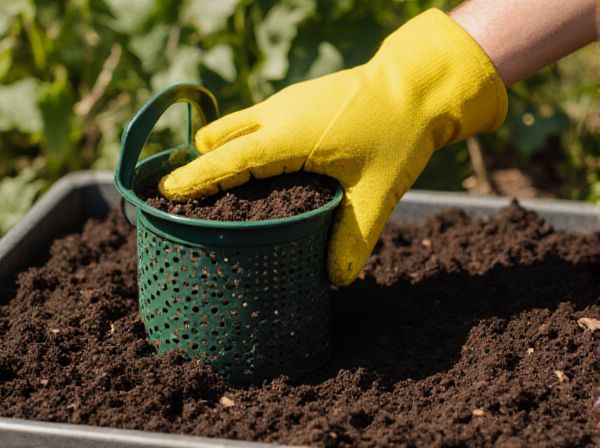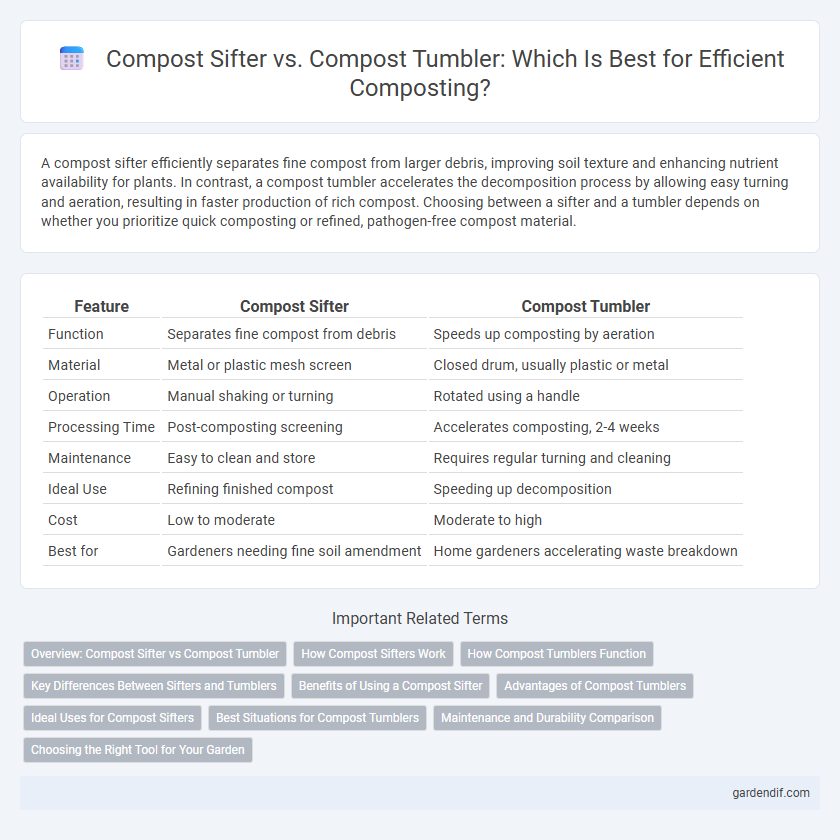
Compost Sifter vs Compost Tumbler Illustration
A compost sifter efficiently separates fine compost from larger debris, improving soil texture and enhancing nutrient availability for plants. In contrast, a compost tumbler accelerates the decomposition process by allowing easy turning and aeration, resulting in faster production of rich compost. Choosing between a sifter and a tumbler depends on whether you prioritize quick composting or refined, pathogen-free compost material.
Table of Comparison
| Feature | Compost Sifter | Compost Tumbler |
|---|---|---|
| Function | Separates fine compost from debris | Speeds up composting by aeration |
| Material | Metal or plastic mesh screen | Closed drum, usually plastic or metal |
| Operation | Manual shaking or turning | Rotated using a handle |
| Processing Time | Post-composting screening | Accelerates composting, 2-4 weeks |
| Maintenance | Easy to clean and store | Requires regular turning and cleaning |
| Ideal Use | Refining finished compost | Speeding up decomposition |
| Cost | Low to moderate | Moderate to high |
| Best for | Gardeners needing fine soil amendment | Home gardeners accelerating waste breakdown |
Overview: Compost Sifter vs Compost Tumbler
A compost sifter efficiently separates fine compost from larger debris, enhancing nutrient-rich soil quality for garden use. Compost tumblers accelerate decomposition by allowing easy turning and aeration within a sealed container, reducing processing time significantly. Choosing between a compost sifter and a tumbler depends on desired compost texture, volume, and speed of production, with sifters ideal for refining finished compost and tumblers suited for active composting cycles.
How Compost Sifters Work
Compost sifters work by separating fine, nutrient-rich compost from larger debris such as sticks, leaves, and partially decomposed material, typically using a mesh or screen. Users manually shake or rotate the sifter over a container to allow smaller particles to fall through while retaining the larger ones for further composting. This process ensures the finished compost is smooth and free of unwanted materials, enhancing its usability for gardening and soil enrichment.
How Compost Tumblers Function
Compost tumblers function by rotating a sealed drum to aerate and mix organic waste efficiently, accelerating microbial activity for faster decomposition. Their design ensures optimal oxygen flow and moisture control, which are crucial for high-quality compost production. Unlike sifters, which separate finished compost from debris, tumblers focus on active composting through mechanical turning.
Key Differences Between Sifters and Tumblers
Compost sifters are designed to separate finished compost from larger debris and undecomposed materials, providing a fine, uniform soil amendment. Compost tumblers accelerate decomposition by allowing easy mixing and aeration through rotating barrels, reducing composting time significantly compared to static bins. The key difference lies in their function: sifters filter and refine compost, while tumblers enhance and speed up the composting process itself.
Benefits of Using a Compost Sifter
A compost sifter accelerates the decomposition process by separating fine, nutrient-rich compost from larger, undecomposed materials, allowing only high-quality compost to be used in gardens. It enhances soil health by ensuring uniform texture and reducing clumps or debris that can hinder plant growth. Using a compost sifter also minimizes waste and improves efficiency by recycling coarse materials back into the composting cycle for continued breakdown.
Advantages of Compost Tumblers
Compost tumblers accelerate the decomposition process by enabling regular and easy aeration through simple rotation, which boosts microbial activity and results in faster nutrient-rich compost production. They are typically enclosed, minimizing odors and deterring pests more effectively than open compost sifters. Their compact design suits limited spaces, providing efficient composting without the mess or extensive manual labor associated with turning traditional compost heaps.
Ideal Uses for Compost Sifters
Compost sifters are ideal for gardeners seeking fine, nutrient-rich soil for seed starting and potting mixes, as they efficiently separate finished compost from larger debris and unprocessed materials. These tools enhance soil quality by ensuring only the finest particles reach plants, improving aeration and nutrient absorption. Compost sifters are especially beneficial for small-scale gardeners and those working with raised beds or container gardening where texture and uniformity significantly impact plant growth.
Best Situations for Compost Tumblers
Compost tumblers are ideal for users seeking rapid decomposition and easier aeration, especially in small to medium-sized gardens or urban settings where space is limited. Their enclosed design helps retain heat and moisture, accelerating the composting process and reducing odors, making them perfect for busy homeowners or those with limited time for regular turning. Compost tumblers also minimize pest problems, making them suitable for environments prone to rodents or wildlife interference.
Maintenance and Durability Comparison
Compost sifters require minimal maintenance, mainly occasional cleaning to prevent clogging, and their simple mesh design ensures long-term durability without moving parts prone to wear. Compost tumblers demand more frequent upkeep, including regular lubrication of moving components and inspection of seals to maintain efficient rotation and containment. While sifters excel in durability due to their static structure, tumblers offer enhanced aeration but may require more maintenance to sustain functionality over time.
Choosing the Right Tool for Your Garden
Choosing the right compost tool depends on your garden's size and desired processing speed. Compost sifters excel at separating finished compost from debris, ensuring a fine, nutrient-rich soil amendment ideal for precision gardening. Compost tumblers speed up decomposition through regular turning, making them suitable for gardeners seeking faster results and minimal manual effort.
Compost Sifter vs Compost Tumbler Infographic

 gardendif.com
gardendif.com